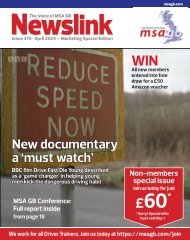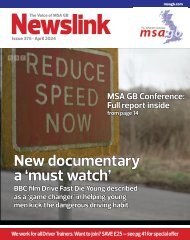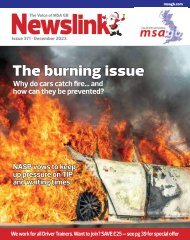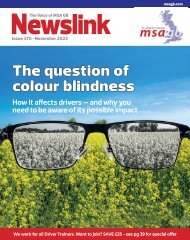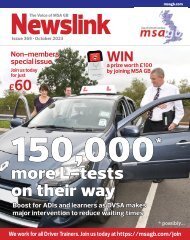Newslink
Motor Schools Association membership magazine, driver training and testing, ADIs, road safety
Motor Schools Association membership magazine, driver training and testing, ADIs, road safety
Create successful ePaper yourself
Turn your PDF publications into a flip-book with our unique Google optimized e-Paper software.
Towards your CPD: The L-test<br />
Stress: It’s the<br />
failure box the<br />
DVSA has left<br />
off the DL25<br />
Simon Elstow thinks it’s<br />
time the driver training and<br />
testing sector takes a long,<br />
hard look at the current<br />
L-test and asks, is it still<br />
fit for purpose?<br />
This is a two-part editorial. In this<br />
issue I want to look at what the<br />
current L-test really does. In Part<br />
2, I want to see if the L-test<br />
supports client-centred learning and ask<br />
the big question, is the L-Test still fit for<br />
purpose?<br />
The following is a criticism of the<br />
L-Test. Throughout I hope, dear reader,<br />
you will see evidence of my humility<br />
about the brave examiners and DVSA<br />
who have to deliver it.<br />
What is the L-Test’s true aim?<br />
Many years ago I sat with John Cullen,<br />
then the DSA’s Assistant Chief Driving<br />
Examiner. I remember how open and<br />
friendly he was. He told me a story of<br />
two tests he observed. One was at<br />
Bettyhill, in the north of Scotland. It<br />
involved a left reverse on the beach,<br />
where the examiner drew an ‘L’ in the<br />
About the author<br />
18<br />
sand with his shoe, so he could<br />
check if the candidate had gone<br />
over the line – genius!<br />
After a drive into the countryside, on a<br />
single track road, and no traffic at all, the<br />
candidate didn’t slow down in response<br />
to a sheep which looked like it might<br />
cross the road. Under the line on the<br />
DL25 which then read ‘Anticipating the<br />
actions of pedestrians/cyclists/drivers’;<br />
the examiner crossed out the word<br />
pedestrian, wrote ‘sheep’ and failed the<br />
candidate.<br />
The second was overseas. While on a<br />
world cruise, John Cullen stopped at Fiji<br />
and asked if he could sit in on a driving<br />
test. The test wound its way around the<br />
island and on returning the examiner<br />
said that unfortunately they had not<br />
passed on this occasion, because<br />
“nothing had happened that sufficiently<br />
challenged” the candidate.<br />
Are we looking for a fail or assessing a<br />
pass? One thing is for sure: if you have a<br />
pedantic test you will get a pedantic<br />
result.<br />
Does the L-Test assess a person to drive<br />
for the real world?<br />
Real world driving is complex. There is<br />
vehicle control, anticipating to blend in<br />
Simon started teaching learners in 1988. He was an instructor trainer for BSM, a<br />
fleet trainer at Drive & Survive plc and training manager for the Institute of<br />
Advanced Motorists. He sat on the DVSA steering group for CPD and was<br />
recently a consultant for ROSPA. He has returned to teaching learners and is a<br />
Porsche Driving Consultant at the company’s experience centre at Silverstone.<br />
Simon holds an MSc in Coaching, a 7307 Teacher’s Certificate and has been a<br />
Grade A (previously Grade 6) instructor for the whole of his professional career.<br />
His passion is Continuing Professional Development – making things better.<br />
with other road users, managing your<br />
journeys and applying emotional<br />
intelligence to driving.<br />
Tricky, that last one. In driving we<br />
might say emotional intelligence is being<br />
aware of your own ‘agendas’ and that<br />
other road users have theirs. And it<br />
means managing the risks of both. So<br />
not just one thing then! This list of skills<br />
is my derivation of the GDE (Goals for<br />
Driver Education) hierarchy; the<br />
European standard, via Finland, Michon<br />
and Maslow.<br />
Can a 38-minute test assess all of this?<br />
I ask my clients what they think<br />
passing the test means, as opposed to<br />
when they are ‘on their own’. One said;<br />
“The test is showing you can control<br />
your vehicle, and driving after your test is<br />
about controlling yourself”. As Gregor<br />
Bartl (an Austrian traffic psychologist)<br />
put it, “The test shows you can, not that<br />
you will”.<br />
It’s important, I think, to make a<br />
distinction between what experience is<br />
and what skills are. I put this as a<br />
question to my clients. One said: “Skills<br />
are things you learn to do, but<br />
experience is learning from different<br />
situations you come across”.<br />
But the L-Test can’t mandate for<br />
experience. The traffic conditions can<br />
mean that the candidate isn’t ‘challenged’<br />
(as in Fiji). It’s too dependent on luck –<br />
what if those sheep hadn’t been there<br />
that day? (as in Bettyhill).<br />
To what extent does the test marking<br />
sheet DL25 reflect reality?<br />
All this test malarkey might pass as<br />
okay if the test criteria was easy to<br />
NEWSLINK n JANUARY 2021




